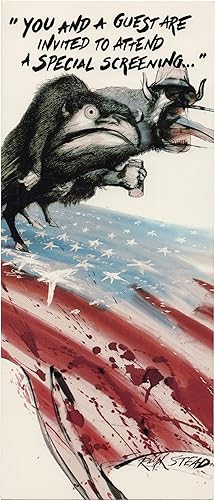hunter thomson ralph steadman art (1 Ergebnisse)
Produktart
- Alle Produktarten
- Bücher
- Magazine & Zeitschriften
- Comics
- Noten
- Kunst, Grafik & Poster
- Fotografien
- Karten
-
Manuskripte &
Papierantiquitäten (1)
Zustand
- Alle
- Neu
- Antiquarisch/Gebraucht
Einband
- alle Einbände
- Hardcover
- Softcover
Weitere Eigenschaften
- Erstausgabe
- Signiert
- Schutzumschlag
- Angebotsfoto
- Kein Print-on-Demand
Land des Verkäufers
Verkäuferbewertung
-
Where the Buffalo Roam (Original screening invitation illustrated by Ralph Steadman for the 1980 film)
Verlag: Universal Pictures, Universal City, 1980
Anbieter: Royal Books, Inc., ABAA, Baltimore, MD, USA
Manuskript / Papierantiquität
Vintage screening invitation for the 1980 film, illustrated by Ralph Steadman on the recto, with film credits on the verso. More than a little loosely based on Hunter S. Thompson's obituary for his closest associate, Oscar Zeta Acosta, a.k.a. Dr. Gonzo, "The Banshee Screams for Buffalo Meat," which appeared in October 1977 issue of "Rolling Stone." A film that, despite being an unholy mess, represents in retrospect an intersection of ideas and talent, as well as the first of many messy attempts to commit to celluloid the basically un-filmable life and work of Hunter S. Thompson. Bill Murray, at this time little more than a droll comedic sensation, arguably made the first step toward becoming the four-dimensional icon he is today, though not necessarily by intention. Both Murray and Thompson had serious concerns about the quality of Kaye's script, and at the beginning of filming both Thompson and Ralph Steadman came onto the set as "executive consultants." Though the author says he did little other than "wander around and fire machine guns," his influence on Murray was profound. The actor became obsessed with his idol, and by all accounts became one with him. During production, Murray and Thompson engaged in a series of dangerous one-upmanship contests, including a Houdini-inspired stunt where Thompson tied Murray to a chair and threw him into a swimming pool. Murray nearly drowned before Thompson pulled him out. The pair's obsession with the film's poor script and continuity led to a hasty final addition of a voice-over narration and two explanatory scenes at the film's end. Three days prior to release, a press screening was canceled because the film was still being edited. When Murray returned to the Saturday Night Live set in the fall of 1980, he was still immersed in character, complete with long black cigarette holder, dark glasses, and nasty habits. One of the show's writers said that Murray .".was not Bill Murray, he was Hunter Thompson. You couldn't talk to him without talking to Hunter Thompson." (Doug Hill and Jeff Weingrad, "Saturday Night Live: A Backstage History," William Morrow, 1989) 3.75 x 9 inches, with a satin finish recto and matte verso. Fine.


